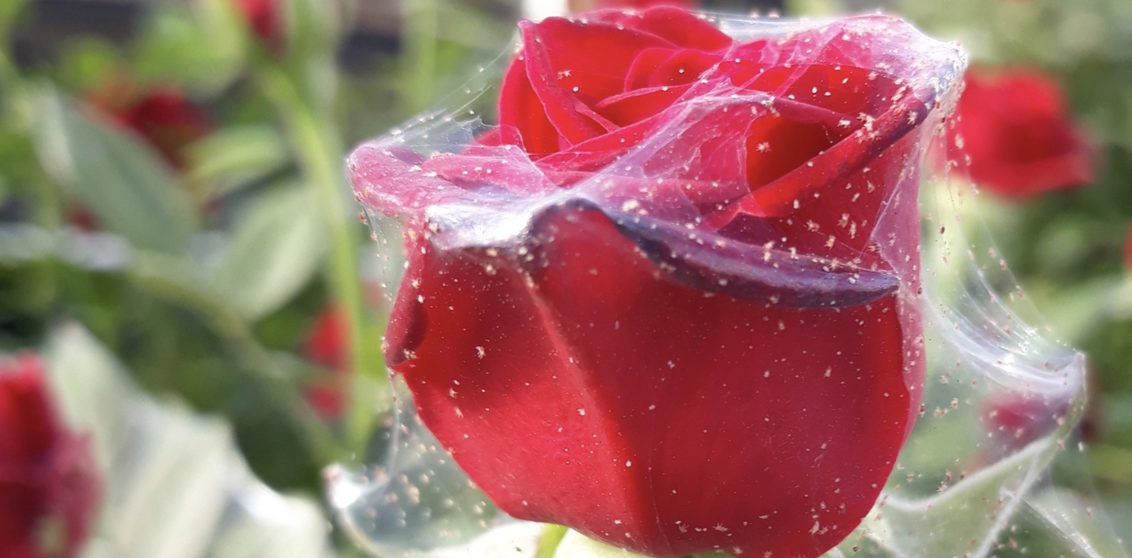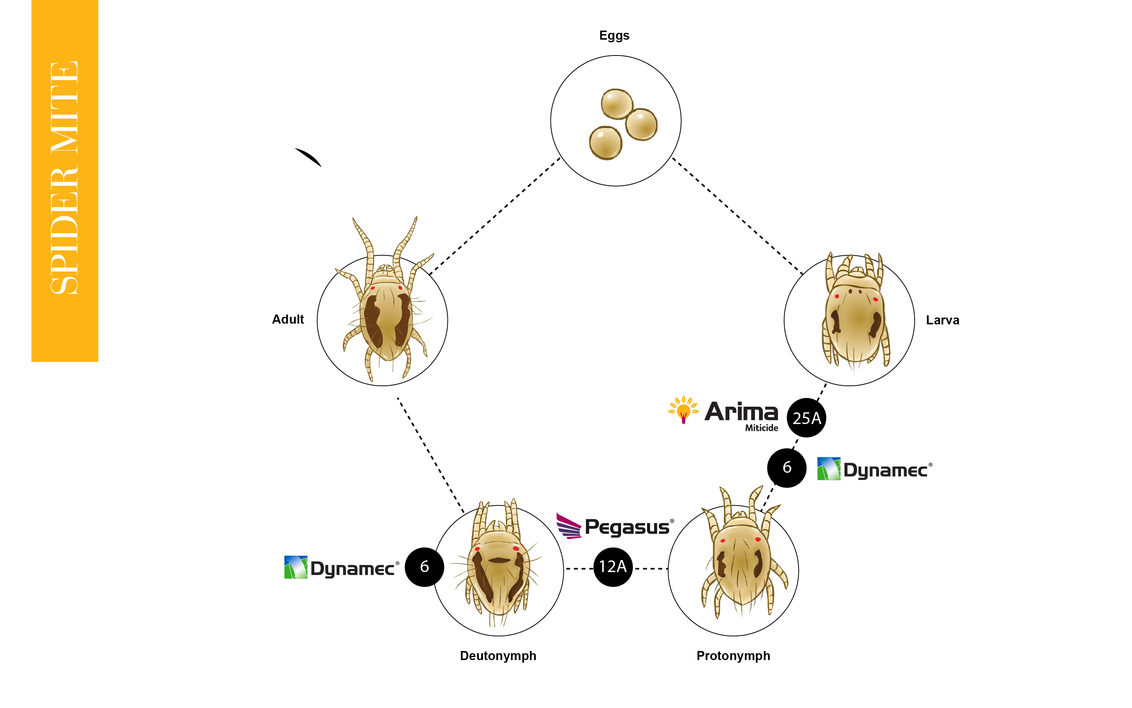Take control of red spider mites in your crop!
Mites are part of the Arachnida, a major class of arthropods. They are in the subclass, Acari hence the insecticides used to kill these pests are called acaricides. The Acari subclass consists of a wide range of Orders or groups of related mites – the main pest Order is the Prostigmata.
• Red spider mite (or two spotted mite) Tetranychus urticae
• Carmine spider mite Tetranychus cinnabarinus
• Bulb scale mite Stenotarsonemus laticeps
Development from egg to adult in mites usually includes a six-legged larva and two or three eight-legged nymphal stages; proto-deuto- and tritonymphs. Adults usually have eight legs. Red spider mite will be discussed in more detail, since it is the most polyphagous and a common pest in the East Africa, UK and worldwide.
Red Spider mites (Tetranychus urticae)
Damage
Mites suck sap from the leaf, causing them to look speckled with yellow marks. Heavily infested plants can be very chlorotic and become stunted and even die as a result of water stress under dry conditions. Heavy infestation can cause premature leaf drop. Red spider mite spins webs and this can not only disfigure plants but makes it more difficult for sprays to reach the leaf surface.

Life cycle
Red spider is a successful pest because it reproduces rapidly by asexual means when environmental conditions are in its favour. Females can lay up to 100 eggs during their life, at rate of about 6 per day. Eggs are about 0.13 mm across, globular and translucent. The time it takes from egg to adult is accelerated by temperature so populations can increase dramatically as summer temperatures rise. At a temperature of 30°C a new generation would be produced every 8 days. Leaf canopy obviously increases as the plants grow, so the difficulty of controlling potential population explosions is compounded by the difficulty of achieving good under-leaf cover with sprays later in the season.

Asexual reproduction
The ability of unfertilized eggs to develop into haploid (one set of chromosomes) females is a distinct advantage since it enables fast reproduction. There is no need to wait for a male to fertilise the egg. If the original female had developed resistance or reduced sensitivity to an acaricide, this character is quickly passed onto the field population. Resistance to chemicals is common and is the reason for adoption of biological controls for this pest.
Diapause (hibernation)
Red spider mite, in its familiar summer form, is not red but a beige mite with two spots on its back. In this form it is commonly known as the two-spotted mite. The two spots are composed of green coloured chlorophyll, which has concentrated in its guts as it has been feeding on the plant's sap.
Cultural Control
Spider mites thrive on plants that are under stress. Be sure to keep plants watered and give them adequate light. Do not over or under fertilize.
Mechanical Control
Spider mites can be dislodged from plants during heavy rains. Growers can reduce mite problems by spraying affected plants with a steady stream of water twice a week during periods of peak mite activity. This has a minimal impact on natural enemies of spidermites.
Biological control of mites
There are several predators, which prey on mite pests, some of which are reared commercially and can be introduced to the crop. They differ in their prey preferences and the environmental conditions, which they prefer. They also differ in their sensitivity to agrochemicals. These factors should be taken into account when developing an IPM programme.
Phytoseiulus persimilis
Phytoseiulus is a predatory mite and as such will move much faster on leaves than spider mite. It has a red pear-shaped body with a glossy appearance and is slightly larger than spider mite.
Phytoseiulus is purchased in phials, each containing 2,000 predators using vermiculite as a carrier. These motile stages are applied directly to the crop by sprinkling the carrier (and predators) onto the foliage as evenly as possible. Ideally every row should be treated. If application is not even, there is the chance that untreated colonies of spider mite will develop into ‘hotspots’ before Phytoseiulus migrates into these areas.
Feltiella
Feltiella acarisuga is a small midgelike insect, which has wings and flies throughout the crop to seek out spider mite colonies. It lays eggs near spider mites. The eggs hatch into small orange-coloured larvae, rather like the aphid predator, Aphidoletes. The larvae consume more spider mite motiles and eggs in a day than Phytoseiulus and are therefore very useful in finding and controlling spider mite hotspots.
Amblyseius cucumeris
Amblyseius is a predatory mite, which feeds on tarsonemid –type mites and thrip larvae (not adults). Amblyseius also feeds on pollen and can therefore survive in the absence of prey for up to 7 weeks. The adult predator is a slightly flattened, pear-shaped mite, pinky-brown in colour and 0.5-1mm long. The young predators are smaller and transparent.
Chemical controls for mites
Insecticides, which kill mites, are called acaricides. Most acaricides provide some control of the Tetranychidae, whereas the Tarsonemidae and Eriophyidae may require acaricides with translaminar movement to complete the control of mites which are concealed in buds and tightly folded leaves.
Examples of these insecticides are Cyenopyrafen (Arima), Pegasus, Abamectin (Dynamec, Avid), Lambda-Cyhalothrin (Karate Zeon) Spinosad, insecticidal soaps and spraying / horticultural oils.
Caution – disclaimer
Always read the pesticide Label YOURSELF before using a pesticide and decide for YOURSELF what the legal restrictions relating to its use are.
